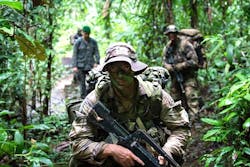Can climbing and flying robots answer the old dilemma of military communications in dense, wet jungle?
THE MIL & AERO COMMENTARY – For infantry, fighting in the jungle never has been easy. It's hot, wet, buggy, hard to navigate, and full of potentially fatal microorganisms. Something else that can make jungle fighting a nightmare is communications -- or the lack of it.
Jungles are tropical rain forests; that's what makes jungle foliage so thick. It can rain in these regions every day, and sometimes days on end without end. It's just this combination -- persistent dripping-wet foliate -- that makes radio communications in the jungle such a problem. All those countless droplets of water coating everything attenuates radio signals to a surprising extent.
These conditions can make it nearly impossible for members of small military units to communicate with one another while operating in the jungle, much less for these small military forces to communicate with their commanders behind the lines.
So what to do? Today's infantry warfighters have to do more than just talk to one another on the radio. They must relay video, still images, text, positioning information, and their health status to keep each other safe, and to let command authorities know what's happening.
Are satellite communications an answer? Maybe, but not always. It's tough to get a clear radio signal through the dense wet foliage of a triple-canopy rainforest. Sometimes the only thing that comes back is static, or worse ... silence.
U.S. military researchers have come up with an idea, and they're reaching out to industry for enabling technologies to flesh-out their vision. It's called the SQUad Intelligent Robotic Radio Enhancing Links (SQUIRREL) project of the U.S. Defense Advanced Research Projects Agency (DARPA) in Arlington, Va.
This project envisions equipping a team of one-pound flying and climbing robots with radio communications relays. These robots would work together to follow small military units throughout the jungle, keeping unit members in touch with one another, and relaying command information via one of these relays located high in the trees to command authorities via satellite links, or by communicating with orbiting unmanned aerial vehicles (UAVs).
Related: iRobot advances state of the art in military robotics
These robots would have to be tough enough to resist the effects of water and mud, slippery tree branches, drops and falls, jungle predators, and rough treatment from the infantrymen who tote them into the rainforest with them.
These robots essentially would create a continuously operating ad-hoc 3D mesh network to extend the range of wireless mobile communication in triple-canopy tropical rainforest. This network would keep small teams of four to six warfighters connected while in the field.
Researchers envision this kind of robot-based ad-hoc mesh network for missions like hostage rescue, scouting, and training allies. From industry, DARPA experts want robot-assisted 3D mesh communications networks that are easy to deploy; function on long missions; offer low noise; are low observable; and offer low probability of detection or intercept.
Related: Unmanned submarines seen as key to dominating the world’s oceans
SQUIRREL also could be useful in public service roles such as search and rescue in densely wooded areas in temperate zones -- particularly in its reachback role. SQUIRREL also could provide commercial communications nodes in dense forests for drug formulation and counting endangered species.
The SQUIRREL mesh must adapt continuously to new settings as it follows and supports the team. To avoid using RF power levels high enough to escape the jungle canopy, SQUIRREL nodes should use low-power RF and free-space optical communications as they move.
Some of these robots must include capabilities for locating, self-positioning, and free-space optical means to reach orbiting unmanned aerial vehicles (UAVs) or other overhead assets for reachback communications. Companies interested in trying their hands at such a project were asked to send proposals to DARPA by late this month.
About the Author
John Keller
Editor-in-Chief
John Keller is the Editor-in-Chief, Military & Aerospace Electronics Magazine--provides extensive coverage and analysis of enabling electronics and optoelectronic technologies in military, space and commercial aviation applications. John has been a member of the Military & Aerospace Electronics staff since 1989 and chief editor since 1995.
